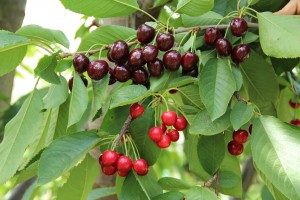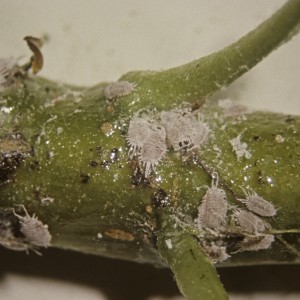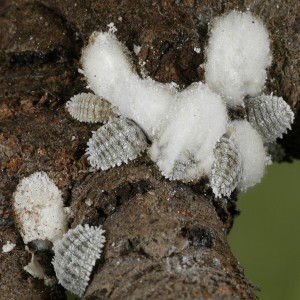Dr. Andrea Bixby Brosi, Dr. Elizabeth Beers, WSU Tree Fruit Research and Extension Center; Tim Smith, WSU Extension Specialist Emeritus; Editor Tianna DuPont, WSU Extension Specialist

Remove Infected Trees
Once Little Cherry Disease is confirmed in an orchard, (via sampling and testing) all trees showing visual symptoms should be removed. Scouting and removal of symptomatic trees in sections of orchard where trees were previously removed due to Little Cherry Disease infection, is a good way to stay ahead of the disease. In some cases it makes sense to remove a whole orchard block when many trees show symptoms.
Mealybug Vectors
Little cherry virus 2 can be spread by the apple and grape mealybug. Because mealybugs don’t cause direct damage to the fruit, mealybug presence was previously not a concern to cherry growers. However, knowing that they can vector LChV2 from tree to tree, control is critical.
Identify Mealybug Species

In order to best target control measures, start by identifying your mealybug population. The two mealybug species differ in appearance as well as lifecycle. Apple mealybug are yellow/green in appearance and egg masses are cigar shaped, while grape mealybug is pink/purple with two tails and egg masses are masses of fluff. Apple mealybug has one generation per year with females emerging from overwintering sites in mid-spring, egg masses are laid around June, and crawlers emerged over the course of an entire month. This long/gradual emergence makes the crawler stage difficult to control with foliar sprays. Grape mealybug has at least 2 generations per year and at some point in the summer; eggs, crawlers, and adults are all present on the same tree, which makes control challenging.

How to Detect Mealybug Populations
Egg masses of both species can be seen on bark, typically near the center (trunk) off the tree. Pulling back loose bark in search of egg masses is another strategy. Apple mealybug adults can be seen feeding in cracks and crevices of bark during the early spring, and crawlers can be found on the undersides of leaves during June, July and August. Grape mealybug crawlers and adults are typically found feeding at the base of fruiting clusters before harvest. When populations are low, it is common for both species of mealybug to reside only in the tops of trees in the un-pruned suckers, making their presence difficult to detect.
Biological Controls: First Line of Defense
Beneficals including lacewings, minute pirate bugs, spiders and ladybeetles are generally quite effective in controlling mealybugs in orchards where their populations have been conserved. Conserve your natural enemy populations by choosing sprays which minimize impact on predators and parasitoids.
In research orchards in 2015 Dr Bixby-Brosi collected and identified the parasitoid wasp Anagyrus schoenherri which has never before been confirmed in Washington. Large quantities of mealybug mummies suggest this parasitoid contributes significantly to biological controls. Two known parasitoids wasps of grape mealybug, Acerophagus notativentris and Pseudophycus angelicus, also contribute to biocontrol. Multiple emergence holes in grape mealybug mummies can easily be seen using a hand lens.
Mealybug Chemical Control (preliminary results)
Researchers tested several approaches to controlling the apple mealybugs: delayed dormant pesticide applications to intercept overwintering females; systemic petal fall applications to target crawlers; and foliar summer sprays timed when 70 percent of the crawlers are estimated to have emerged.
In the 2014 trial, a combination of Lorsban and oil was found to be most effective at the delayed-dormant stage. Diazinon worked best at controlling the newly hatched crawlers later in the summer. They repeated the research in 2015 to the same results, with one addition: A combination of Centaur and oil also was effective at the delayed-dormant stage. Lorsban is rated as high toxicity on natural enemies. No ratings were found for Centaur.
For grape mealybug, systemic compounds, Admire Pro (soil drench) and Ultor and oil, applied 14 days after petal fall showed the best results.
In general delayed dormant oils were not as successful as hypothesized. In 2016 Dr Bixby-Brosi and Dr. Beers plan to trial repeated applications of horticultural oil and neem oil.
Please keep in mind that efficacy ratings will be continually refined as more information becomes available.
For additional information visit these links: